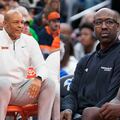SU students complete barn project in Brady Farm community garden partnership

For the past year, a group of SU students worked with Brady Farm, a local community garden, to help design and construct a barn. The project is part of decades of supporting community gardens in the Syracuse area. Courtesy of Devon Banks Photography
Get the latest Syracuse news delivered right to your inbox.
Subscribe to our newsletter here.
For 5th-year architecture student Mingrui Xie, supporting the community through university projects fosters an important relationship for cities like Syracuse.
Over the past year, Xie and other architecture students at Syracuse University collaborated with Brady Farm, a local community garden, to help design and construct a modern produce barn in Syracuse’s Southside.
“Syracuse and the local community collaboration is almost like a tree giving nutrients to the soil, and soil giving nutrients back to the tree,” Xie said. “It’s very important that the resources going into the university are coming back to the community.”
Architecture professor Hannibal Newsom began the university’s collaboration with Brady Farm after former SU professor David Shanks introduced him to the farm’s work.
Since 2016, Brady Farm has provided affordable food in Syracuse’s Southside neighborhood, Newsom said. The farm also offers job training and nutrition education for local schools, but didn’t have a space to provide that education on the farm until now.
Newsom, along with Brady Farm Coordinator Jessi Lyons, realized the farm’s most pressing need was an indoor space where the farm could sell vegetables year-round.
Menghan Zha, an SU graduate student, helped design the physical model for the barn, contributing to a Brady Faith community fundraiser that raised over $25,000, Newsom said.
Zha said the project was a great opportunity to engage with the city of Syracuse and made her feel like she was a part of the community. Zha added that she was able to gain insight into the phases of building and design throughout the process.
“The biggest lesson for me was to see the real construction process, in the studio we develop a design and it’s finished,” Zha said. “But for this project, I was able to keep developing until the barn was completely built.”
Employees have said the new barn raises community awareness for the farm, Newsom said. He noted the design’s intentionally vibrant blue color, serving as a “visual statement” about investing in the community.
“One of the reasons we wanted to make a design statement, as opposed to a pre-engineered barn that would be like everything else, was a desire to do something more,” Newsom said.
The project was funded through several donors, including an SU SOURCE grant and an initial investment by Hayner Hoyt Corp, which provided Brady Farm a pro-bono project manager.
Lyons said the farm has become much more efficient since the project’s completion. Now, it’s able to have market space open in the winter and continue selling produce, something that was not possible in previous years.
The project is part of decades of supporting community gardens in the Syracuse area, Lyons said. In 2008, she helped create the nonprofit organization Syracuse Grows and began her work as Brady Farm coordinator in 2016.
Lyons said Brady Farms has been able to ready itself for rising food insecurity. After the longest United States government shutdown in history paused Supplemental Nutrition Assistance Program benefits, more than 50,000 Onondaga County residents were left without benefits.
Since then, she said the farm has looked at how the community may need extra support, given the farm’s role in providing food assistance.
“This is what we do all the time, it’s our mission,” Lyons said. “It’s interesting to me that we have politicians who are actively trying to find ways to prevent people (from) getting access to food when that’s our entire organization’s main objective.”
Newsom said while universities often create community projects focused primarily on their own students, his project emphasizes putting community at the forefront.
He said the best way for students to internalize the architectural details of the designs they create is by physically building the thing they are drawing. Unlike many architecture projects focused primarily on design, this project gave students hands-on experience, even building much of the furniture by hand.
“The learning is automatic because students gain that real-world experience,” Newsom said. “The goal is to make sure that community members are the primary target for the work, and trust that students gain those same learning opportunities.”
Xie, one of six undergraduate students who helped design the barn’s interior, echoed this sentiment. Studying for five years as an architecture student, he said he mostly draws and works with models, rather than building the project itself. He said he’s “very passionate” about the barn.
“It was so exciting to see this building in front of me that looks exactly like the model that I made,” Xie said.
Newsom said Brady Farm was chosen as a partner because of its positive track record and ability to take care of new infrastructure.
“A building can’t do anything on its own, but if it’s occupied by a community organization that can use it productively, then the architecture can become a real asset,” Newsom said.





